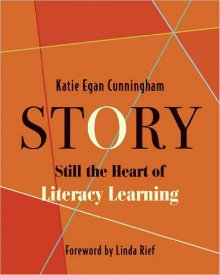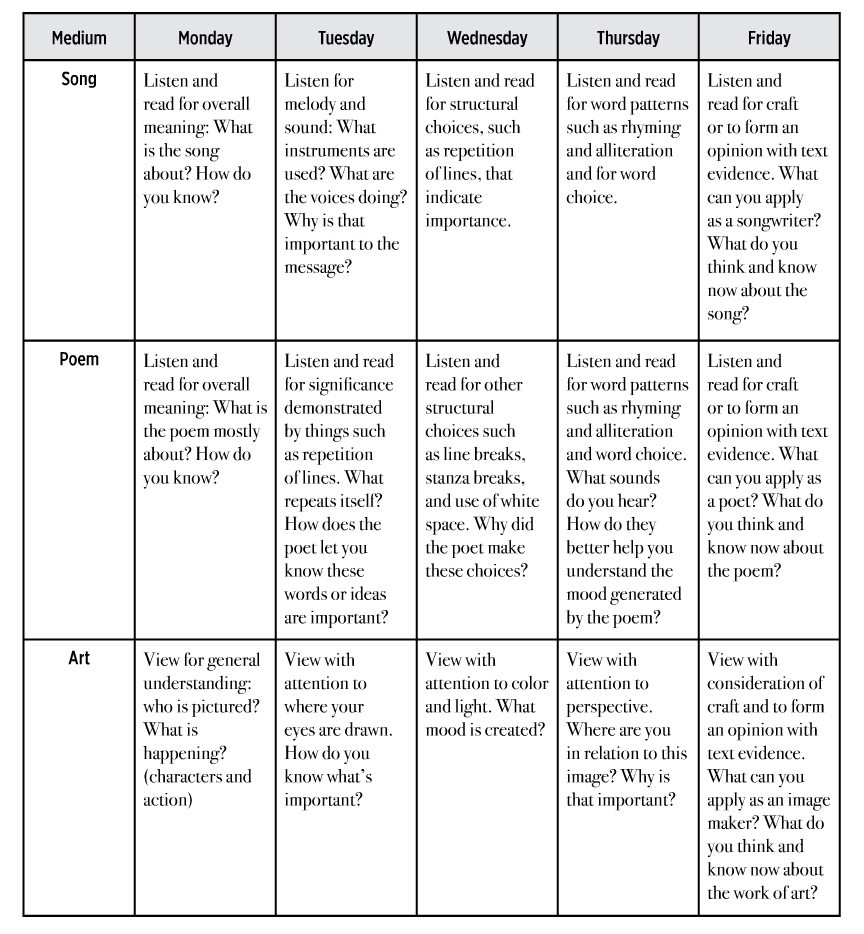Bring Story to the Center of Literacy Learning
Story: Still the Heart of Literacy Learning
By Katie Egan Cunningham
(Stenhouse, 2015 – Learn more)

I still remember the stories that were handed down from generation to generation in my family. How during the Great Depression families would come home to find their belongings on the curb and have no place to live. How my grandmother would welcome them into her home until they were able to find work.
These stories gave me a sense of my family and affected who I later came to be. Stories are the soul of family traditions, moments of joy and sorrow. They bond a family together.

Story: Still the Heart of Literacy Learning is a book that binds together the literacy family. We need to remember that our students still want to tell their stories but they are doing it with technology, such as Snapchat and Instagram.
The heart of literacy learning
I was intrigued by the title, Story: Still the Heart of Literacy Learning. Where did Katie Egan Cunningham feel “story” fit in with the Common Core State Standards and curriculum? As I read the book, I was amazed by the authenticity of the author and how story was directly linked to the CCSS.
In Story Cunningham has authored a book that examines the importance of story in our students’ lives and in our own lives. Her book makes us examine our own lives and stories and encourages us to make stories the “heart of language arts classrooms.” She encourages us to build libraries that portray characters’ diverse backgrounds and cultures. She asks us to give ourselves time to reflect on our own literate lives and the stories we give our students to read.
It didn’t take me long to fall in love with this book. I soon knew that I would be devouring each word and page. I knew that I would be putting into practice what I had read. I knew that this book needed to be part of each teacher’s educational story and journey. What I didn’t know was what an impact this book would have on my life.
A treasure trove of help
Children are literate learners the day they learn how to communicate. Many of their first literacy experiences involve telling stories by drawing or painting pictures in preschool. “This is me playing with my dog.” Simple, but meaningful. Stories live and breathe in art, music, and photography. Stories exist through oral storytelling and written expression. It’s our job to continue the joy and enthusiasm kids have for storytelling as young learners, and Cunningham shows us how keep that spark alive.
Cunningham’s book is a treasure trove of help. She shows us how stories live in the visual arts. She encourages us to take a risk and experiment with stories in art, music, multimedia, video, and even “Mash-ups” (where artists and storytellers select existing material, combine selections, and make something new and original). She urges us to collaborate and partner with our colleagues who are teaching the arts. She implores us to become the thinkers and creators we wish our students to be – to become actors as we read aloud to our students to engage them and give them opportunities to visualize what is on the page.
Story is mesmerizing. Based on pedagogical theory, it delivers to the educator inspiration and content. This book helped me understand how to adapt my teaching so that my students would believe in the power of their words and stories. Cunningham offers suggestions to help teachers change their teaching practices while being cognizant of their district’s prescribed curriculum.
The appendix, with an annotated bibliography of suggested resources, is golden in itself. There you will find examples of children’s literature to use in the classroom, TED talks, This I Believe essays, songs, graphics, paintings, websites, and professional literature. The author inspires in us the hope that as we meet our students each day, we will help them become self-directed, insightful, and motivated.
Beyond the E/LA classroom
This book definitely needs to be in the hands of all teachers, not just teachers of language arts, and to be the focus of a PLC (Professional Learning Community). Certainly, this well-researched text should be in the hands of our media specialists or librarians. Teachers of all disciplines need to be actively reading Story and discussing ways to incorporate the ideas into their classrooms.
Examine, for example, the chart (p. 89) below. What better way to engage the students in close reading and show them that literacy is all around us!
Touching the lives of children
Cunningham has a gift with words. She applies analogies to story writing such as writers being architects. In one chapter, she notes that while we often ask students to “add details” to a piece, they struggle with what the abstract term “add details” specifically means. Her advice, simple yet effective, encourages students to build stories from a “writers-as-architects” point of view, starting with the foundation, thinking about structure, and finding the tools to bring it altogether.
Although the book is documented throughout with research and data, you don’t feel inundated with information. Her gift is to reach out to the teacher in us who wants to touch the lives of all our children. She encourages us to take a risk and dare to create space for vulnerability. Throughout the book I was touched by the stories she told, experiences that she was a part of, or stories she had heard. However, I was not ready for the final chapter when she asked teachers to watch the documentary film, Children Full of Life (Kaetsu 2003).
Cunningham writes, “If you haven’t seen this film yet, put this book down immediately and take forty minutes to watch it from start to finish.” I hope all readers will take time to watch this movie and think about the stories your children want to share, the stories you want to tell, the books that you want to share with them, the gift of the written word. I encourage you to take the time to read this book. I guarantee it will change your life.
Linda Biondi is a fourth grade teacher at Pond Road Middle School in Robbinsville, NJ, and a long-time Morning Meeting practitioner. She’s also the recipient of several educational grants, a Teacher Consultant with the National Writing Project and a participant on the NJ Department of Education Teacher Advisory Panel. Linda participates in ECET2 Celebrate Teaching which has posted an interview with her.



































